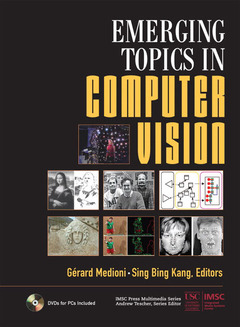Emerging topics in computer vision, (with DVD)
Langue : Anglais
Auteurs : MEDIONI Gerard, BING KANG Sing

The popularity of topics in computer vision shifts periodically, precipitated by what actually works or shows great promise, changing interests in applications, and on occasion, fortuitous advancements in hardware technology. Some of these topics remain popular over the years, such as facial recognition and modeling from images, while others are relatively new, such as computer vision techniques for graphics and the application of level-set theory in computer vision. Many currently popular topics in computer vision tend to be multidisciplinary. The primary aim of this book is to provide a snapshot of topics that are currently popular in computer vision and enable the curious to get a quick grasp of such topics. Each chapter is a self-contained primer on a particular subject of current interest, and is suitable for use in an introductory short course. The chapters are written by leading researchers in their respective fields. In addition, the accompanying DVD contains lectures by the contributors to provide the reader a quick multimedia overview of the topics addressed in the book. This book is intended for researchers and technical practitioners in computer vision and other closely allied fields such as computer graphics and image processing. No advanced technical background knowledge is necessary in order to understand the contents of the book.
Preface. Contributors. 1. Introduction. I. FUNDAMENTALS IN COMPUTER VISION. 2. Camera Calibration. Zhengyou Zhang. Introduction. Notation and Problem Statement. Camera Calibration with 3D Objects. Camera Calibration with 2D Objects: Plane-Based Technique. Solving Camera Calibration with 1D Objects. Self-Calibration. Conclusion. Appendix: Estimating Homography Between Plane and Image. Bibliography. 3. Multiple View Geometry. Anders Heyden and Marc Pollefeys. Introduction. Projective Geometry. Tensor Calculus. Modeling Cameras. Multiple View Geometry. Structure and Motion Part 1: Structure and Motion II.. Autocalibration. Dense Depth Estimation. Visual Modeling. Conclusion. Bibliography. 4. Robust Techniques for Computer Vision. Peter Meer. Robustness in Visual Tasks. Models and Estimation Problems. Location Estimation. Robust Regression. Conclusion. Bibliography. 5. The Tensor Voting Framework. Gérard Medioni and Philippos Mordohai. Introduction. Related Work. Tensor Voting in 2D. Tensor Voting in 3D. Tensor Voting in ND. Application to Computer Vision Problems. Conclusion and Future Work. Acknowledgments. Bibliography. II. APPLICATIONS IN COMPUTER VISION. 6. Image-Based Lighting. Paul E. Debevec. Basic Image-Based Lighting. Advanced Image-Based Lighting. Image-Based Relighting. Conclusion. Bibliography. 7. Computer Vision In Visual Effects. Doug Roble. Introduction. Computer Vision Problems Unique to Film. Feature Tracking. Optical Flow. Camera Tracking and Structure from Motion. The Future. Bibliography. 8. Content-Based Image Retrieval: An Overview. Theo Gevers and Arnold W. M. Smeulders Overview of Chapter. Image Domains. Image Features. Representation and Indexing. Similarity and Search. Interaction and Learning. Conclusion. Bibliography. 9. Face Detection, Alignment, and Recognition. Stan Z. Li and Juwei Lu. Introduction. Face Detection. Face Alignment. Face Recognition. Bibliography. 10. Perceptual Interfaces. Matthew Turk and Mathias Kölsch Introduction. Perceptual Interfaces and HCI. Multimodal Interfaces. Vision-Based Interfaces. Brain-Computer Interfaces. Summary. Bibliography. III. PROGRAMMING FOR COMPUTER VISION. 11. Open Source Computer Vision Library. Gary Bradski. Overview. Functional Groups: What's Good for What. Pictorial Tour. Programming Examples Using C/C++. Other Interfaces. Appendix A. Appendix B. Bibliography. 12. Software Architecture For Computer Vision. Alexandre R. J. François. Introduction. SAI: A Software Architecture Model. MFSM: An Architectural Middleware. Conclusion. Acknowledgments. Bibliography. Index.
Date de parution : 05-2004
Ouvrage de 704 p.
18x24 cm
Thèmes d’Emerging topics in computer vision, (with DVD) :
© 2024 LAVOISIER S.A.S.



